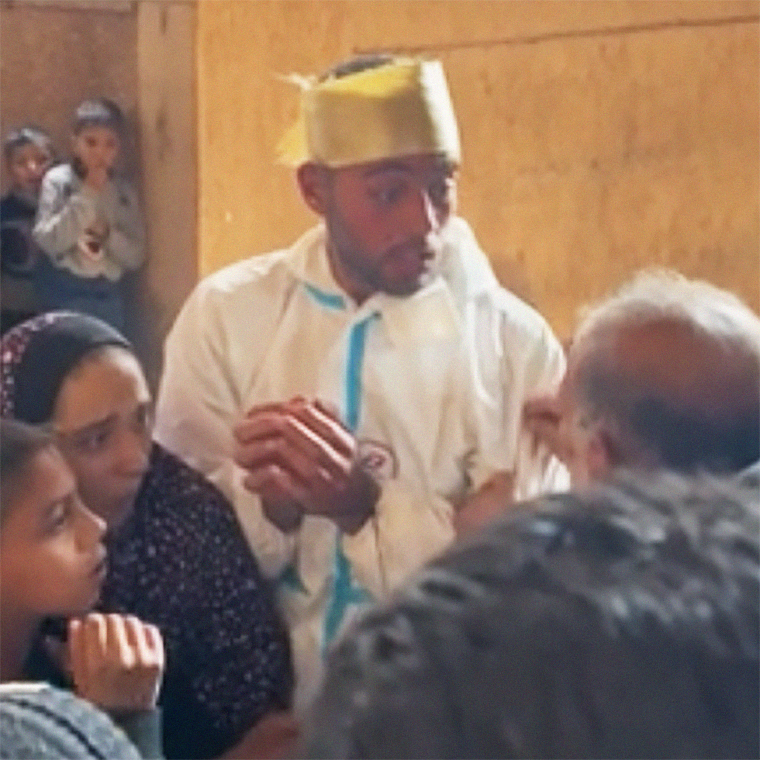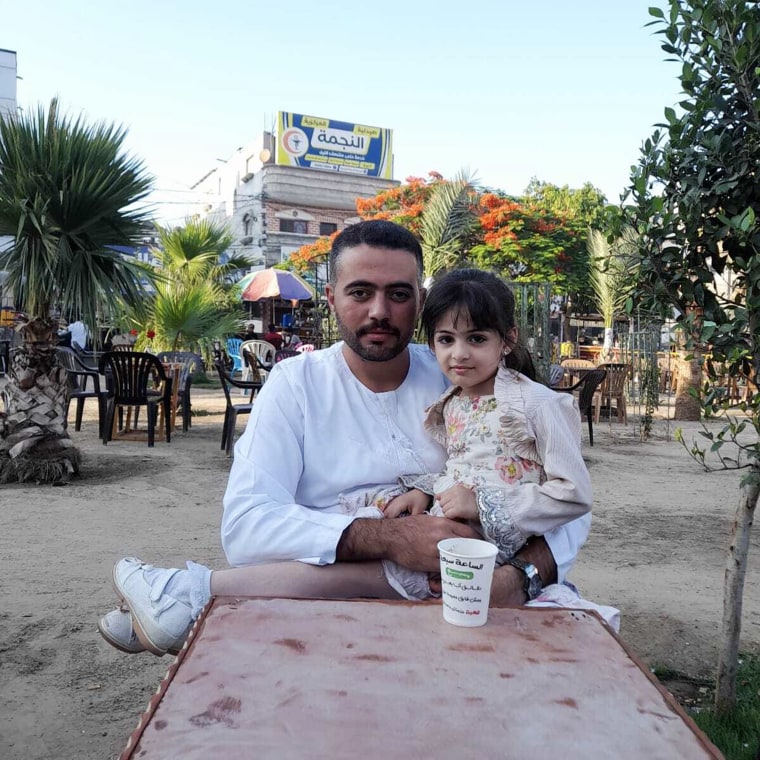A man with his hands bound urged a Gaza hospital to evacuate. Hours later, he was shot dead.
TEL AVIV — Dressed in a white hazmat suit, his hands bound with plastic cable ties and a yellow cloth tied around his head, Jamal Aldin Muhammed Jamal Abu Al-Ola’s appearance surprised onlookers when he walked into the Nasser Hospital complex in the southern city of Khan Younis.
Allegedly dispatched as a messenger by the Israeli military, which was conducting operations around the hospital, he was filmed several times as he walked around the facility and inside the hospital where thousands of people had sought shelter from Israeli bombardment. Several witnesses told NBC News he warned people to evacuate the area.
Less than two hours later, he was shot dead.
Within hours, a video of the 25-year-old sharing his message to evacuate ricocheted around the internet, quickly going viral before garnering attention from several mainstream media outlets.
While a full picture of the events leading up to his death remains unclear, NBC News has been able to piece together much of Abu Al-Ola’s final hours through interviews with witnesses and an analysis of video taken on Feb. 13, the day he was killed.

Early that day, the 25-year-old appeared in another video obtained by NBC News with a yellow piece of fabric appearing to be over his eyes. He stood near what NBC News geolocated as the north gate of the hospital.
Abu Al-Ola was again seen on camera inside a hospital building at around 12:50 p.m. local time when he was filmed by journalist Mohammed El Helo, who had been documenting events at the hospital for months after fleeing Israel’s military campaign in northern Gaza.
Abu Al-Ola’s hands remained bound, with the yellow cloth resting across his forehead. His eyes were wide, his expression alert, but weary, as a crowd of people jostled around him to hear him speak.
Some appeared to ask him questions, but the audio was unclear.
Dr. Mohammed Harara, whose work NBC News had been documenting at Nasser since December and who witnessed Abu Al-Ola talking, said in a text message last week that he had entered the hospital with a warning.
“Everybody should leave,” Abu Al-Ola said, according to Harara. “They are going to destroy everything here.”
This account echoed that of Abu Al-Ola’s mother, Raeda Rafiq Ali Abu Al-Ola, who had been sheltering at the hospital with her sons. They fled their home in Khan Younis shortly after Israel began its military campaign in the enclave, following Hamas’ Oct. 7 attacks.
She said Abu Al-Ola was detained by Israeli forces the day before he was killed as he tried to leave the hospital complex to try to visit his younger brother Omar Hussam, 24, who was being treated for a gunshot wound at the Shuhada Al-Aqsa Hospital in the nearby city Deir al-Balah.
Raeda Abu Al-Ola, 45, said that on the day her son was killed, he “came to bring the message: Evacuate Nasser Hospital.”

Raeda Abu Al-Ola said he was wearing a strawberry-colored shirt, a green jacket and black jeans before he was detained. They had been replaced by the hazmat suit.
Both she and El Helo said he appeared to have been beaten. Raeda Abu Al-Ola said he had a bruise on his face that wasn’t there before. In the video taken at 12:50 p.m. he appears to have a small mark under his eye. No other injuries were visible in the video.
Just over an hour later at around 2:05 p.m., El Helo’s journalistic colleague Mohammad Salama, filmed Abu Al-Ola walking away from the hospital and back toward the north gate.
Salama’s video shows a small crowd of men and children following him until he nears the gate. Then, a man from the group can be seen patting him on the back before appearing to gesture with his hand for the children to stay back before Abu Al-Ola continued on alone.
In a separate video taken around the same time, Abu Al-Ola could be seen appearing to gesture toward a bulldozer in the same area as he speaks with a group of people on the complex’s grounds. While the bulldozer isn’t clearly identifiable as being part of the Israeli military, neither Palestinian fighters nor hospital workers are known to have used bulldozers in or around Nasser Hospital.
Near the bulldozer were large mounds of sand, which a video analysis found had been constructed in the days leading up to Abu Al-Ola’s death. Footage published on Instagram by Dr. Khaled Al Serr, a surgeon at the hospital, showed a bulldozer appearing to push sand into the area on Feb. 10. He posted a video of the mounds later that day.
On the morning of Abu Al-Ola’s death, footage published on Instagram by Salama showed a bulldozer and an armored vehicle with what appeared to be a blue-and-white Israeli flag attached to the top. Hamas is not known to have any tanks in its arsenal.
Raeda Abu Al-Ola and El Helo said Abu Al-Ola told them he had to return to the custody of the Israel Defense Forces.
El Helo said Abu Al-Ola told him “he would be killed” if he failed to return to Israeli custody. Raeda Abu Al-Ola said she begged him not to go but he told her Israeli soldiers had threatened to kill her along with a group of men he had been detained with the day before his death.
Raeda Abu Al-Ola said she watched on as her son was gunned down as he walked out of the hospital grounds.
“They executed him in front of me,” she said, adding that his hands were still bound as he was shot. Although she could not see who fired, she said the bullets appeared to come from the sand mounds near the north gate.
At around 3:45 p.m., less than two hours after the last footage of him alive was taken, Abu Al-Ola was filmed in a body bag inside the hospital grounds. His glazed eyes were still open as a grave was dug beside him.
Harara said he heard the gunshots that killed Abu Al-Ola. He added that a group of men were able to retrieve the body, which he said had two bullet wounds to the chest and a third in his abdomen. Raeda Abu Al-Ola and El Helo also said they saw his wounds.
In a statement the day after Abu Al-Ola’s death, the IDF said the “incident in question” was under review. NBC News has asked several times for an update and none has been received.
Separately, the IDF said soldiers were fighting in the area that day after the Gaza Health Ministry said in a statement that three people had been killed and 10 wounded by snipers in the vicinity of the hospital. El Helo also said people had been shot as they tried to heed Abu Al-Ola’s warning and leave the hospital.
Two days after his death, Israeli forces launched a sweeping raid on the hospital.

IDF spokesman Rear Adm. Daniel Hagari said people sheltering inside the facility had been urged “in Arabic, on the phone and via loudspeakers” to leave the facility through an evacuation route and the hospital would be able to continue operating.
The Gaza Health Ministry has said in several statements that at least eight patients have died due to a lack of oxygen and power outages during the raid. It said that dozens of medical workers and staff at the hospital were among those detained.
Hospitals are considered specially protected facilities under international humanitarian law, Hisham Mhanna, a spokesperson for the International Committee of the Red Cross in Rafah, said Friday. He said it wasn’t only about “the patients and the injured at the medical centers and hospitals,” but also other civilians who “have been displaced inside these hospitals.”
After watching her eldest son die, Raeda Abu Al-Ola said she fled to Rafah, where Omar Hussam’s bullet wound is still being treated.
“It’s a crime,” she said. “A crime in front of his mother.”





